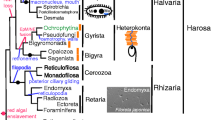Summary
The microgametogenesis of Haemoproteus columbae was investigated by high voltage and conventional electron microscopy and the results were compared. The features of microgametogenesis which have become clear by high voltage electron microscopy include the distribution and arrangement of axonemes in the microgametocyte and the budding process and structure of the microgametes. High voltage electron microscopy shows that prior to exflagellation the axonemes occupy a major portion of the microgametocyte cytoplasm, and are arranged in an orderly fashion. Conventional electron microscopy suggests that the axonemes are randomly distributed in the microgametocyte cytoplasm. High voltage electron microscopy shows that a short portion of the axoneme protrudes outward in the early stage of microgamete budding, while the major portion remains within the cytoplasm. The microgamete of H. columbae as observed by the high voltage electron microscope, is composed of a slender nucleus and an axoneme which run along the same axis and spiral one another. The nucleus is slightly bulbous at the anterior end and at the midportion of the microgamete. These findings have not been obtained with certainty by conventional electron microscopy because the thin section technique could not provide a sufficient profile of the long wavy microgamete.
Similar content being viewed by others
References
Aikawa, M.: Plasmodium: High voltage electron microscopy. Exp. Parasit. 32, 127–130 (1972)
Aikawa, M., Huff, C. G., Strome, C. P. S.: Morphological study of microgametogenesis of Leucocytozoon simondi. J. Ultrastruct. Res. 32, 43–68 (1970)
Bradbury, P. C., Roberts, J. F.: Early stages in the differentiation of gametocytes of Haemoproteus columbae Kruse. J. Protozool. 17, 405–414 (1970)
Bradbury, P. C., Trager, W.: The fine structure of microgametogenesis in Haemoproteus columbae Kruse. J. Protozool. 15, 700–712 (1968)
Desser, S. S.: The fine structure of Leucocytozoon simondi. I. Gametocytogenesis. Canad. J. Zool. 48, 331–336 (1970)
Dupouy, G.: Electron microscopy at very high voltages. In: Advances in optical and electron microscopy (R. Barer and V. E. Cosslett, eds.), vol. 2, p. 167–250. New York: Academic Press 1968
Garnham, P. C. C., Bird, R. G., Baker, J. R.: Electron microscope studies of motile stages of malaria parasites. V. Exflagellation in Plasmodium, Hepatocystis and Leucocytozoon. Trans. roy. Soc. Trop. Med. Hyg. 61, 58–68 (1967)
Sterling, C. R.: Ultrastructural study of gametocytes and gametogenesis of Haemoproteus metchnikovi. J. Protozool. 19, 69–76 (1972)
Sterling, C. R., Aikawa, M.: A comparative study of gametocyte ultrastructure in avian haemosporidia. J. Protozool. 20, 81–92 (1973)
Author information
Authors and Affiliations
Additional information
This work was partially supported by a research grant (AI-10645) and a Pathology Training Grant (GM-01784) from the U.S. Public Health Service. M.A. is a Research Career Development Awardee (AI-46237) of the U.S. Public Health Service.
Rights and permissions
About this article
Cite this article
Aikawa, M., Sterling, C. High voltage electron microscopy on microgametogenesis of Haemoproteus columbae . Z.Zellforsch 147, 353–360 (1974). https://doi.org/10.1007/BF00307470
Received:
Issue Date:
DOI: https://doi.org/10.1007/BF00307470




